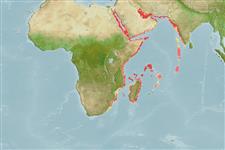Teleostei (teleosts) >
Tetraodontiformes (Puffers and filefishes) >
Balistidae (Triggerfishes)
Etymology: Rhinecanthus: Greek, rhinos = nose + Greek, akantha = thorn (Ref. 45335).
Eponymy: Pablo Ruiz Picasso (1881–1973) was a Spanish painter and sculptor. The vivid patterns and colours of Rhinecanthus triggerfish have led to them being popularly known as picassofish. Not an eponym but reported by Forsskål as being a local Arabic name for the fish – ‘Azzazi’. (Ref. 128868), visit book page.
Environment: milieu / climate zone / depth range / distribution range
Ecology
Marine; reef-associated. Tropical
Western Indian Ocean: Red Sea to the Gulf of Oman.
Size / Weight / Age
Maturity: Lm ? range ? - ? cm
Max length : 30.0 cm TL male/unsexed; (Ref. 8883)
Inhabits shallow sandy and rubble areas of coral reefs (Ref. 9710). Juveniles are commonly found on reef flats (Ref. 9710). Feeds on benthic invertebrates (Ref. 30573). Caught with artisanal gear, mainly pots (Ref. 30573).
Life cycle and mating behavior
Maturity | Reproduction | Spawning | Eggs | Fecundity | Larvae
Randall, J.E., 1986. Red Sea reef fishes. London, Immel Publishing. 192 p. (Ref. 8883)
IUCN Red List Status (Ref. 130435: Version 2024-1)
Threat to humans
Harmless
Human uses
Tools
Special reports
Download XML
Internet sources
Estimates based on models
Preferred temperature (Ref.
123201): 24.7 - 29.3, mean 27.1 °C (based on 230 cells).
Phylogenetic diversity index (Ref.
82804): PD
50 = 0.5078 [Uniqueness, from 0.5 = low to 2.0 = high].
Bayesian length-weight: a=0.02692 (0.01267 - 0.05719), b=2.92 (2.74 - 3.10), in cm total length, based on LWR estimates for this (Sub)family-body shape (Ref.
93245).
Trophic level (Ref.
69278): 4.5 ±0.13 se; based on food items.
Resilience (Ref.
120179): Medium, minimum population doubling time 1.4 - 4.4 years (Preliminary K or Fecundity.).
Fishing Vulnerability (Ref.
59153): Low vulnerability (20 of 100).
Nutrients (Ref.
124155): Calcium = 44.9 [18.9, 113.7] mg/100g; Iron = 0.604 [0.311, 1.379] mg/100g; Protein = 18.4 [16.3, 20.6] %; Omega3 = 0.12 [0.06, 0.23] g/100g; Selenium = 34.4 [17.9, 71.0] μg/100g; VitaminA = 57.1 [16.7, 200.0] μg/100g; Zinc = 1.05 [0.71, 1.55] mg/100g (wet weight);
